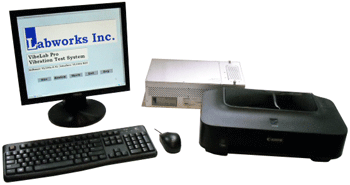|
Labworks VibeLab Controllers:
— General Specifications and Features — |
|
|||||||||||||||||

Complete Controller System Includes:
- Computer
- VibeLab and Windows™ software installed and tested,
ready to run
- Monitor
- Keyboard
- Mouse
- Printer
- VibeLab Shaker interface PC board w/accel. bias supply(s)
installed and tested
- Accelerometer package: (1) -100 mV/g accelerometer,
cable, stud, and mounting base
The Gen II VibeLab Vibration Controller is an industrial computer-based vibration test controller. Running under the Windows™ operating system, the controller is designed to generate and run user-defined vibration tests. The electrical output of the VibeLab controller is a real-time voltage signal suitable for use in driving most commercially available wide band vibration test systems. VibeLab utilizes vibration acceleration feedback from one or two accelerometers mounted on the shaker, fixture, and/or test article.
Taking full advantage of the Windows™ environment, VibeLab provides a comfortable and straight forward user interface that allows creation and running of vibration tests with minimal time spent learning to use the controller. All critical settings are software interlocked and cross checked to insure that only valid tests are generated. The virtual instrument approach to the controller user interface puts all of the user required settings and parameters in view, with minimal hidden menu activity required in defining or running a vibration test.
During test program generation, VibeLab considers the user's vibration system and test load characteristics in its calculations to insure that all testing specified is within the capabilities of the particular system. While running the test, VibeLab can be configured to monitor the vibration system operating level and even abort its operation if exceeded. Most common vibration systems are included in the VibeLab system library or the user can easily define and store custom system parameters.
Full output metering is provided during both program generation and vibration testing. Metric or English units are displayed based on the user preference and automatic conversion from one unit system to the other simplifies acceleration and displacement calculations. Acceleration, velocity, and displacement are all displayed simultaneously. The program screen meters display the acceleration, velocity, and displacement of the programmed reference levels during the programming phase. Any parameter exceeding the capabilities of the vibration test system are flagged on the screen and the effects of changes to the programmed levels are instantly shown on the meters. Full metering is also displayed in the run test screen, giving the current level of the control channel acceleration, velocity, and displacement as well as the individual channel acceleration, velocity, and displacement for sine vibration.
Sinusoidal vibration control can be configured to either of the input channels, the average of the two channels, or extremal (highest acceleration of the two channels). The Sine controller can be programmed for frequency sweeping logarithmically, linearly, step to programmed break points, step at even 1 Hz increments, or resonance search and dwell. In addition, its transducer calibration mode can record calibration sensitivity automatically at each user-defined calibration frequency and level.
Random vibration control can be configured to either of the input channels, the average of the two channels, or the extremal (highest acceleration of the two channels). The controller run time can be configured for continuous, external, timed, or cycling testing. Continuous testing is controlled using manual start and stop commands. External start and stop is easily performed in response to a simple switch or relay closure. A four function, re-setable timer is programmable to perform cycled or timed shut down testing as required.
Shock vibration control can also be configured to either of the input channels, the average of the two channels, or extremal. The controller can be configured for manual or automatic pulse triggering during both the equalization phase as well as the full test pulse phase. Automatic shock pulse triggering can be terminated after a set number of pulses or a total elapsed time has been reached. External control can also be used to start and stop automatic shock pulse generation. Shock analysis includes frequency, time and shock spectrum domains.
VibeLab incorporates a sophisticated three-tier password system that allows for individual programming and test running functions access based on password codes. A limited access VibeLab internal calibration control panel along with calibration log are provided to facilitate periodic VibeLab calibration.
Individual vibration test programs can be stored with all display, system, channel, control, etc. information included for instant recall of a particular test setup. In addition to VibeLab's vibration system library and program memory, individual test results can be stored along with any program or setup changes in effect. These stored tests can be easily recalled for continued testing, re-analysis, or delayed report generation. In addition to stored programs and tests, VibeLab retains a preferences program file that is automatically loaded whenever the system is turned on. These preferences are easily changed and saved by the user.
An automatic test log is recorded as the test is run including time stamping all pertinent changes to the test under progress. This Log can be printed directly to the printer or copied to the PC clipboard for transfer to another Windows™ program for inclusion. Up to 10 complete sets of data can be included with saved test data. One complete data set is automatically saved as the "Last Test" whenever the system is stopped. All saved data can be recalled and re-analyzed at any time to allow for custom report generation or delayed analysis.
VibeLab's primary report output is graphical. Either a single large or two smaller graphs can be prepared and printed directly, or copied, to the PC clipboard for inclusion on other Windows™-based applications. Each graph carries its own notation field that prints automatically in the direct print mode. The test log header includes the name of the parent test program for reference. Any two data sets can be displayed on each graph and cross hairs are provided for specific level or frequency identification if required. The data files saved are spreadsheet compatible for custom report generation.
VibeLab Controller Specifications
